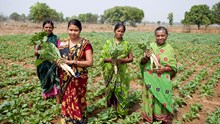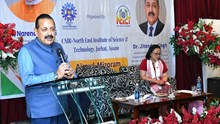
As we mark World Suicide Prevention Day, Vidarbha’s story stands as a stark reminder of the silent crisis that once gripped rural Maharashtra. Mounting debt, repeated crop failures, and social isolation had pushed countless farmers to the brink. What unfolded in the region over the past decade offers critical insight: financial aid alone is not enough. Tackling farmer suicides requires an integrated response that addresses emotional resilience, community rebuilding, and the sustainability of agricultural livelihoods.
In this evolving landscape, the work led by Gurudev Sri Sri Ravi Shankar and The Art of Living Foundation has emerged as a model for holistic rural transformation rooted in mental well-being, natural farming, and collective hope.

Crisis of Farmer Suicides in Vidarbha
“A few years ago, Vidarbha witnessed a tragic wave of farmer suicides. During that time, everyone was concerned about how to support the farmers,” shared Shweta Mahale (MLA, Chikhli Constituency) in a poignant address at Kishan Samruddhi Mahotsav 3.0, held earlier this year which drew 1000 farmers from drought-prone districts of Marathwada and Vidarbha to The Art of Living International Center, “It was Gurudev Sri Sri Ravi Shankar who extended a helping hand to them.”
She added, “He uplifted the morale of the farmers. The Art of Living is the only organization that works holistically on mental health, society, and nature. Through initiatives like Jalyukt Shivar and The Art of Living’s various projects, significant improvements have been made across Maharashtra. In 2024 alone, these efforts led to a rise in groundwater levels, directly improving the quality of life for farmers.”
In 2006, as Vidarbha reeled from relentless debt, crop failure and a grim drumbeat of suicides, Gurudev expressed deep concern for the rising farmer suicides. “No farmer should have to resort to suicide,” he said.
A Holistic Approach: Mindfulness and Sustainable Farming
What emerged in Vidarbha was not a single silver bullet but a braided and a more holistic solution, whose results would last for decades to come: stress-relief programs of The Art of Living that included powerful breathing techniques like Sudarshan Kriya and simple meditation techniques to steady despondent minds; village-level youth leadership programs to rebuild confidence and create community leaders; and natural-farming know-how to lower costs, bring farmers out of the debt cycles and get them on track to profits, prosperity and health. For those who had run out of options, it offered something unexpected: room to breathe and a hope to begin again.

Rebuilding from Within: Stories of Change and Community Resilience
Sanjay Manikdarkar, a cotton farmer, remembers standing on that edge. “I was tired of life and on the verge of committing suicide,” he says. “The Art of Living programme changed my life. Now I have found a new direction in life and motivation to cultivate my own land.” His words are echoed by neighbors who describe the same arc- from paralysis to participation- after village programs combined breathwork, peer support and farm training.
The psychosocial support was also crucial and timely. Even as relief packages and loan waivers came and went, state officials acknowledged that despair and not only debt, was driving deaths. The Art of Living’s model leaned into that insight, organized short stress-relief, pranayama, and meditation camps to re-energize communities before mobilizing them for practical steps like rainwater harvesting, building recharge structures, and training in natural farming. In villages across Amravati and neighboring districts, thousands of farmers learned Sudarshan Kriya while youth volunteers coordinated farm demonstrations and group service activities.
Crucially, the “mindset” work was paired with a reset on farming practices. Natural farming- mulching, intercropping, indigenous seeds, cow-based inputs, which cut dependence on expensive chemicals and imported seeds that often trap smallholders in debt. Over the past decade and longer, AoL’s Natural Farming project has trained more than 30 lakh farmers nationwide, including in suicide-prone belts, building local seed banks, certifying produce, and creating market linkages so lower costs actually translate into steady income.
Anand Rao Sabde, who had quit cultivating after repeated losses, says the breathing practices made him “stronger and happier,” while the natural-farming sessions nudged him back to his fields. Young farmer Pradeep T (name changed) dropped alcohol and gutkha and stopped leasing out his three acres: “The skills I learnt gave me the confidence to cultivate my own land instead of giving it out to others.”
The work has also been public. At mass gatherings in distressed villages, Gurudev urged farmers to pledge that neither they nor their neighbors would take their lives. When moral suasion comes from the Master, it gives hope and tremendous inner strength. “Give me this guru-dakshina,” he told one crowd in Vidarbha, “a promise that none of you will ever take you’re your own life, come what may.”
Transforming Lives and Communities: Impact and Expansion
A decade and a half on, the model has widened well beyond Vidarbha. In Maharashtra alone, The Art of Living has convened several farmer meets and signed partnerships to scale natural farming and market access, while volunteers continue water-rejuvenation and stress-relief work in drought-hit talukas. At one 2024 gathering in Pune, thousands of cultivators and village heads publicly credited the approach with “positive changes and abundance” in their lives, a phrase that, in farm country, often simply means a season without debt collectors.
Elsewhere, the organization’s training pipeline continues to push practical value chains, helping farmers certify produce under India’s PGS system, connecting them to direct-to-consumer “Kisan Basket” models, and honing local leadership so that change lasts beyond a single season.
None of it makes headlines the way tragedy does. But in hamlets where the worst had begun to feel normal, these outcomes matter.
The transformation witnessed in Vidarbha and beyond is a testament to how compassion, community action, and an act of going back to one’s roots, has come together to solve a problem as complex as farmer distress. Gurudev Sri Sri Ravi Shankar’s approach through The Art of Living has shown that healing the farmer’s mind is as vital as healing the land. By addressing both the psychological toll of crisis and the economic traps of modern farming, these initiatives have not only prevented suicides but also restored dignity, hope, and sustainability to thousands of lives.
















